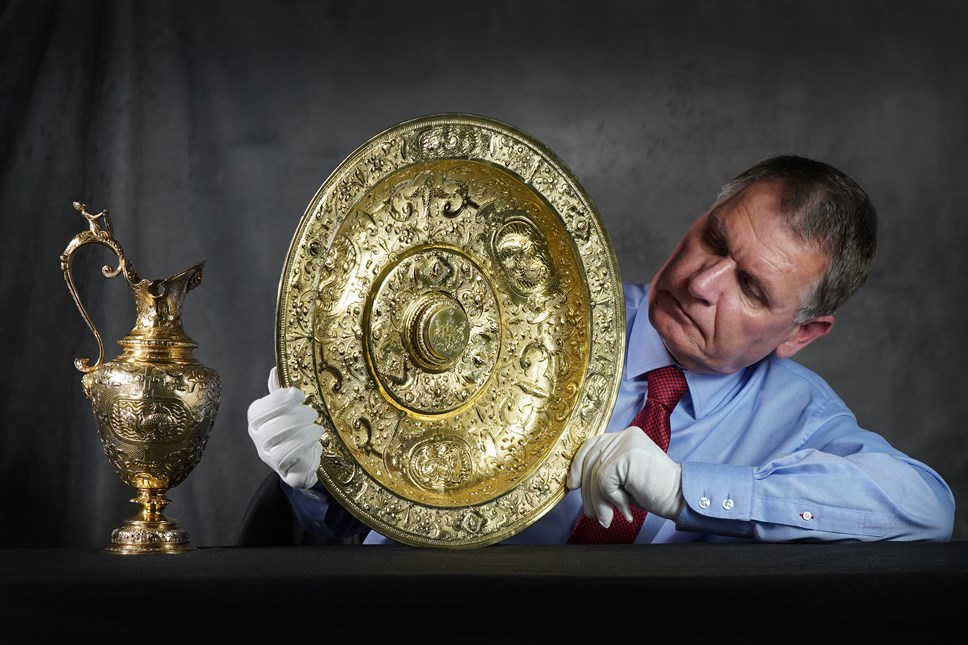
Rare 16th century ewer and basin acquired for the nation
A very rare 16th century silver-gilt ewer and basin have been acquired for the nation and allocated to National Museums Scotland under the Acceptance in Lieu scheme.
A selection of press images can be downloaded here.
A video of Dr Godfrey Evans, Principal Curator of European Decorative Arts at National Museums Scotland discussing the acquisition can be downloaded here.
The Panmure ewer and basin go on permanent display from today [1 November] at the National Museum of Scotland in Edinburgh. They have been accepted in lieu of inheritance tax by His Majesty’s Government from the collection of the Earls of Dalhousie and allocated to National Museums Scotland by Arts Council England and Christina McKelvie, Scotland’s Minister for Culture, Europe and International Development.
During the 16th century, ewers and basins such as these were used by elite members of society for ceremonially washing hands at meals. Queen Elizabeth I alone had at least 40 sets of silver or silver-gilt ewers and basins in 1574, but today fewer than a dozen sets made in London before 1600 survive.
Created in London in 1586 or 1587 by the goldsmith HC (who was probably the Dutch immigrant goldsmith Harman Copleman), the Panmure ewer and basin would have been used ceremonially and also displayed proudly on a buffet to impress people with the owner’s wealth and status. The ritual of hand washing at a banquet, using scented rosewater, was widely practiced by royalty and aristocrats in the 16th century.
Dr Godfrey Evans, Principal Curator of European Decorative Arts at National Museums Scotland said:
“I am delighted that this remarkable set has been acquired for Scotland under the Acceptance in Lieu scheme. Most similar examples were melted down, making the Panmure ewer and basin an exceptionally rare survival. Their craftsmanship is particularly fine and the representations of lots of scaly dolphins, flying fish, snails and other weird and wonderful animals offer us a glimpse into a period when such objects demonstrated the wealth, power and sophistication of the elite.”
The Panmure ewer and basin is one of fewer than a dozen sets made in London before 1600 that are still in existence. Most of the other best sets are in Corpus Christi College, Cambridge, the Ashmolean Museum in Oxford, the Rijksmuseum in Amsterdam and the Museum of Fine Arts in Boston, Massachusetts.
In 1967, the Panmure ewer and basin were exhibited in Treasures from Scottish Houses: European Decorative Arts in what was then the Royal Scottish Museum. They are now on permanent display in the Art of Living gallery at the National Museum of Scotland. Research will now be carried out to try to discover more about their maker and how they were acquired by the important Scottish Whig politician, William Ramsay Maule, 1st Baron Panmure (1771-1852), the second son of the 8th Earl of Dalhousie and the father of the 11th Earl of Dalhousie.
Christina McKelvie, Minister for Culture, Europe and International Development said:
“I’m really pleased National Museums Scotland is now in possession of these beautiful Renaissance pieces for the public to enjoy. These are a welcome addition to its outstanding collection, obtained through the Arts Council England’s Acceptance in Lieu Scheme.”
Notes to editors
- National Museums Scotland is one of the leading museum groups in the UK and Europe and it looks after collections of national and international importance. The organisation provides loans, partnerships, research and training in Scotland and internationally. Our individual museums are the National Museum of Scotland, the National Museum of Flight, the National Museum of Rural Life and the National War Museum. The National Museums Collection Centre in Edinburgh houses conservation and research facilities as well as collections not currently on display.
- Twitter: @NtlMuseumsScot
- Facebook: www.facebook.com/NationalMuseumsScotland
- Instagram: @NationalMuseumsScotland
2. The Panmure ewer and basin were acquired through the Acceptance in Lieu scheme and their acceptance settled £1,256,000 of tax.
3. The Acceptance in Lieu scheme is administered by the Arts Council. The Acceptance in Lieu Panel, chaired by Michael Clarke CBE, advises on whether property offered in lieu is of suitable importance and offered at a value which is fair to both nation and taxpayer. AIL allows those who have a bill to Inheritance Tax to pay the tax by transferring important cultural, scientific or historic objects to the nation. Material accepted under the scheme is allocated to public collections and is available for all. In the last decade this important government initiative brought £479m worth of treasures into public ownership for the enjoyment of all - see more here.
4. For more information about the Acceptance in Lieu scheme and the Arts Council, please contact: Mabel Jenkin-Smith, Communications Officer, Museums and Cultural Property, Arts Council England
Email: Mabel.Jenkin-Smith@artscouncil.org.uk
5. Details of the work is as follows: An Elizabeth I rosewater ewer and basin, 1586, silver-gilt, maker’s mark ‘HC’ flanking a gauntleted arm holding a hammer, possibly for either Henry Cowley or Harman Copleman, London, 1586. Ewer: 109 ¼ oz (scratch weight), 36.5cm (height) and 1,281g (weight). Basin 45.7cm (diameter) and 2,075g (weight).
